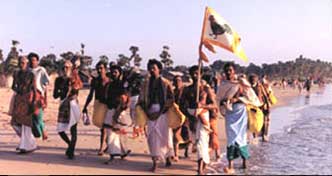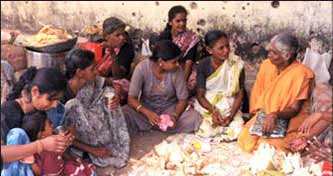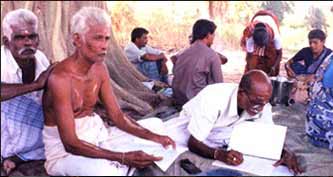
|
||||||||||||||
|
| ||||||||||||||
 'National Vision' lets villagers' voices be heardA Multicultural National Vision for Trust Building and Co-Existence in Sri Lanka
(Trincomalee district, June 27, 2003) A high-powered committee responsible for formulating a National Vision has adopted a novel approach to incorporate rural opinion from remote villages of the North and East. The National Vision aims to lay out a roadmap to a peaceful and prosperous Sri Lanka that is a multi-cultural, multi-ethnic, multi-faith, and plural society, where cultural diversity is recognized as a source of national wealth and strength. Combining age-old local traditions with digital technology, a mobile computer-equipped unit is following the traditional Kataragama Pada Yatra foot pilgrims on their long march from village to village all the way from Mullaittivu to Kataragama. The project aims to promote open discussions, collect villagers' insights, and forward summaries by Internet to the Colombo-based Inter-ministerial Committee for a National Vision. When villagers come out to greet the pilgrims and offer dana, they are invited to offer ideas as well—their personal experiences, recommendations and suggestions on how best to establish lasting peace with justice and prosperity for all. The villagers' suggestions are recorded by volunteers among the Pada Yatra pilgrims, collated and entered on computer, and dispatched weekly by e-mail in summary form to Committee officials in Colombo. The mobile project, called 'Let the Villagers be Heard', has already submitted field reports from Mullaittivu and Trincomalee districts, and is now following the Pada Yatra through Batticaloa and Ampara districts. It will continue all through the Kataragama Esala festival before publishing its findings. VisionariesLiving Heritage Trust spokesman and Inter-ministerial Committee member Manik Sandrasagra, who proposed the project, argues that the National Vision, in order to be widely accepted as valid, should respect and solicit grassroots village opinion, especially from villagers in remote districts that bore the brunt of violence, displacement, and destruction during two decades of conflict. "Naturally, the Committee for a National Vision also plans to conduct dialogue and consensus building through urban seminars and town-hall type discussions for policy makers, academics, visionaries, educators, and the media," says Sandrasagra, adding that "These should result in specific policy changes." "But what about the villager who does not speak bureaucratic English? What about the overwhelming majority of our villager elders who cannot come to Colombo to make their views heard?" "Something had to be done to bring villagers into the process of policy building. Committee members living in Colombo pleaded that they could not undertake this task. So we said, why not let the Pada Yatra pilgrims conduct it for the Committee all the way from Mullaittivu to Kataragama? The National Vision Committee and the Kataragama Devotees Trust both agreed to give the concept a chance." LTTELTTE Political Wing officials in Mullaittivu District proved to be receptive to the idea of a speedy process that gathers and forwards information about local issues to the attention of high-level authorities in Colombo. Throughout the Wanni region, villagers concur that an overall political solution is an absolute prerequisite to any secondary social and development solutions. This year's Pada Yatra and accompanying National Vision project also served to highlight one of the resettlement issues confronting LTTE and Government officials alike. While the A-9 land route to the North has long been open to traffic, other land routes remain closed. Among them is the east coastal road from Mullaittivu to Trincomalee via Pulmodai. Situated along this route in the midst of the broad no-man's-land separating the LTTE and Government security forces are three Tamil coastal villages: Kokkuttoduvay, Karnattukerny and Kokkilay. Kokkilay near Pulmodai is now occupied mostly by fisher folk of other ethnic communities, while Kokkuttoduvay and Karnattukerny remain unoccupied and unsafe due to large unmapped fields of land mines. In 2002, the LTTE and Government security forces mutually agreed to allow the Pada Yatra pilgrims to circumvent the no-man's-land by proceeding from Chemmalai to Pulmodai by fishing boat. This year, however, the LTTE was adamant that the Pada Yatra pilgrims should resume the normal passage by land only via the three coastal villages as early as possible. It refuses to allow any further passage by sea until the normal land route is reopened and the three villages resettled by the original displaced inhabitants. The Pada Yatra pilgrims—including the National Vision mobile unit—had no safe alternative but to travel by vehicle back to Vavuniya and thence to Pulmodai, where they resumed their normal walking and interviewing through remote areas. Over one hundred foot pilgrims—many in their 70's and 80's—crossed from Trincomalee to Batticaloa District on 29 June when they crossed the Verugal River. The project van also serves as a support vehicle to the Pada Yatra, along with a second support vehicle used by a small team of artists who are documenting this year's Pada Yatra on video tape. As it always has been, the Pada Yatra remains a colourful and unmistakable sight. According to the draft version of the National Vision for Sri Lanka recognises that "targeted violence against civilian populations reduced many communities to a state of despair, destroyed the social fabric, and subjected an entire generation of children to violence and distrust. While all communities suffered, the people of the North and East of the country bore the brunt of violence, displacement, and destruction." The National Vision draft also declares that "displaced minorities will be provided protection to return and communities encouraged to work together in reconstruction and rehabilitation activities as a means of rebuilding local level ethnic and community relationships…local knowledge, innovations and practices of indigenous and local communities embodying traditional lifestyles will be respected, preserved and maintained." Patrick Harrigan (M.A., University of Michigan) has been the Kataragama Devotees Trust's Pada Yatra field representataive since 1988. The 2003 Pada Yatra was his 17th Kataragama Pada Yatra since 1972. "National Vision Committee convenes in Kataragama" |
|
| Living Heritage Trust ©2023 All Rights Reserved |


